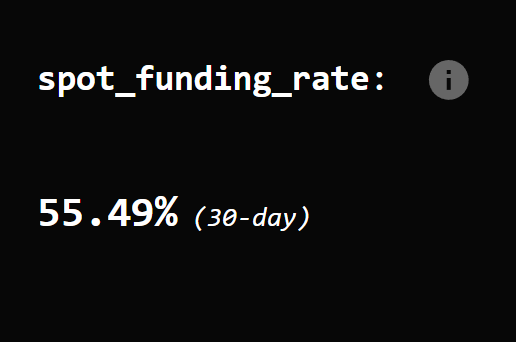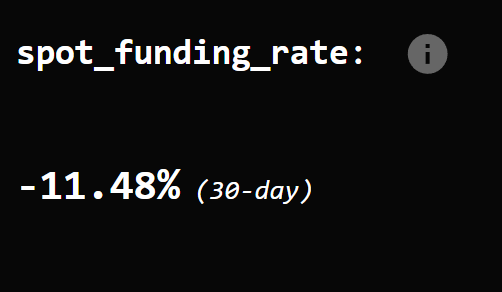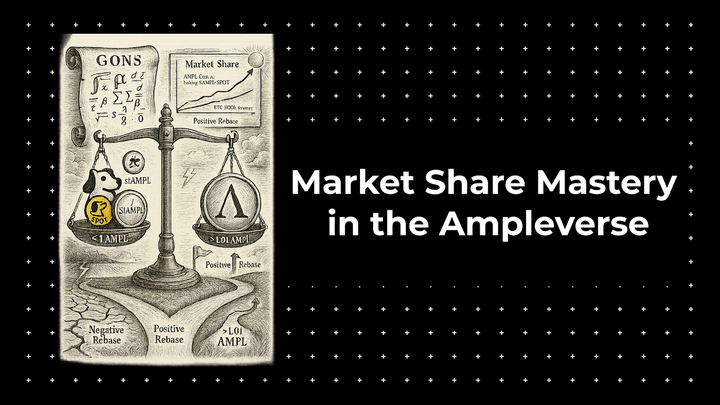Funding Rate Mastery: How to Amplify your gains

One of the most fascinating features of the Ampleforth ecosystem is the funding rate. The funding rate dynamically incentivizes traders to balance demand between two AMPL derivatives, Spot (low-volatility AMPL) and stAMPL (high volatility / leveraged AMPL).The premise of the funding rate is very simple. At a high level, the system will pay a funding rate to Spot if there is high stAmpl demand, and a funding rate to stAmpl if there is more demand for Spot than stAmpl.
While many DeFi protocols favor annualized metrics like APY or APR, the Spot funding rate is quoted as a 30-day yield. This approach, while different from crypto’s usual APY/APR yields, actually brings Ampleforth in line with major traditional markets.
In institutional finance, rates like futures basis, repo, and money-market yields often appear as returns over one week, two weeks, or 30 days. Funding obligations for leveraged long positions are typically assessed far more frequently, sometimes even in 8-hour blocks for liquid perpetual contracts.
In this way, Ampleforth’s Spot funding rate acts as a precise tool for harvesting imbalances between demand for stAMPL and Spot, much like how basis trades extract profit from discrepancies between spot and futures in traditional finance. A similar mechanism underpins Ethena’s synthetic dollar (USDe): it maintains a delta-neutral position by holding staked ETH while simultaneously shorting perpetual futures. The difference between those two legs is the funding rate and that becomes the system’s yield.
Likewise, in the Ampleforth ecosystem, when the demand for leverage or yield tilts toward stAMPL, the Spot funding rate adjusts to reflect that imbalance. Arbitrageurs or liquidity providers can then capture the spread, restoring equilibrium. Just as Ethena’s traders profit from the futures premium over spot ETH, Spot participants harvest yield from the dynamic between leveraged (stAMPL) and unleveraged (Spot) exposure, effectively turning volatility and demand imbalance into a yield source.
Additionally, the funding rate is paid on a daily basis to stAmpl or Spot. This also helps the system achieve a balance without intervention of the market.
Spot Funding Rate
Positive funding rate going from stAmpl to Spot. (Note: Funding rate can go up to 100%)

Negative funding rate going from Spot to stAmpl.

Where does the payment from Spot to stAmpl come from? It comes from Spot’s collateral. During times when the funding rate is being paid from Spot to stAmpl, the value of the collateral base becomes worth less than before (otherwise known as debasement).
Conversely, if the funding rate is positive, Spot is paid from the Ampl backing stAmpl, and it will increase the value of the collateral (otherwise known as enrichment).
stAMPL Yield
A positive stAMPL yield means the funding rate currently paid + fees received over the last 30 days is net positive.

A negative stAMPL yield means the funding rate currently paid + fees received over the last 30 days is net negative.

Funding Rate Strategies
With the funding rate mechanics out of the way, I know most of you are asking -”Ok, looks nice, but how do I make money from this?”
There are a couple of strategies that can be accomplished (with the help of a lending market)
Strategy #1 - Spot Cash and Carry Trade
When Funding Rate is flowing into Spot:
- Borrow USDC (or another stablecoin) against WAMPL
- Buy or mint Spot below FMV.
- Hold until the funding rate is no longer positive.
- Sell Spot back for USDC, repay the loan, and pocket the 30-day yield.
Let's unpack this. Some of you may ask, “Why not just buy and hold Spot?” or “Do I have to borrow against WAMPL?”. Sure, you can just buy and hold Spot, with it being a low volatility cryptocurrency, the risk is low that the price crashes or anything out of the ordinary happens.
But let's look at why borrowing WAMPL makes sense - typically if Spot has a positive funding rate, it is also due to WAMPL expanding. So combining holding WAMPL while it is expanding combined with extracting the funding rate can be more profitable than just buying Spot alone.
Strategy #2 - stAMPL Cash and Carry Trade
When Funding Rate is flowing into stAMPL:
- Borrow WAMPL (or alternatively a stablecoin)
- Mint stAmpl
- Hold until the funding rate is no longer positive.
- Unwind the position, repay the loan, keep the funding profit.
Very similar to the Spot trade, the advantage of this is that instead of keeping the stAmpl long term, you can gracefully exit out whenever the trade is profitable enough. There are some who do not want the long term commitment of staking AMPL over long periods of time.
Conclusion
The best news about extracting the funding rate, is that it requires no trading skills and a very simple logic flow. Spot, stAMPL, and protocols like Ethena are pioneering real yield in DeFi by focusing on short-term, verifiable returns. This delivers institutional-grade funding rate arbitrage for everyone, and creates an opportunity to make gains no matter the state of the market.




